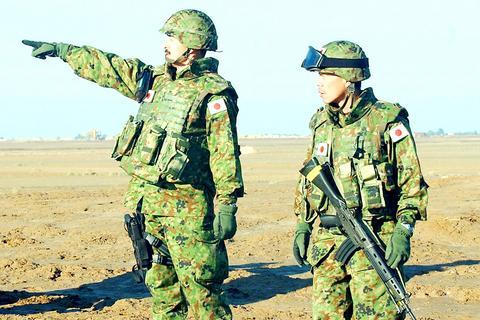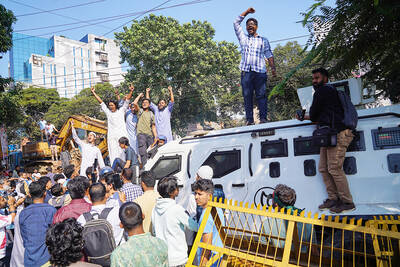Japanese soldiers, embarking into a conflict zone for the first time in a half-century, inspected the site of their future base in southern Iraq yesterday amid reports of a possible terrorist plot against them.
A group of about 10 Japanese troops drove up in four cars -- followed by hordes of reporters, TV cameramen and photographers -- to a muddy field outside this southern town where the camp will be built.

PHOTO: AP
They spent 20 minutes looking around before returning to the Dutch garrison at Camp Smitty where the 30-member Japanese contingent is based temporarily. The Japanese contingent will be 1,000 strong by the time it is fully deployed in March.
The noncombat group, comprising engineering and water purification units, will help purify local water supplies, rebuild schools and provide medical care in Samawah and surrounding areas.
Samawah lies about 230km south of Baghdad.
The troops arrived in southern Iraq late Monday overland from Kuwait.
Japanese defense chief Shigeru Ishiba yesterday told reporters in Tokyo that the government was investigating reports of a possible terrorist plot against the troops, based on unspecified information. He did not elaborate.
"We don't have the details, but such information should be investigated over there," Ishiba was quoted as saying by a Defense Agency spokesman.
"It is the advance team's mission to assess the local security situation," he said.
The Japanese army mission is the biggest for Japan's military overseas since the end of World War II and the first to be deployed in a war zone.
The dispatch has triggered widespread opposition in Japan with polls indicating a majority of the public believes the mission is too dangerous, or opposes it because it might violate the country's postwar pacifist Constitution.
Earlier yesterday, Japanese Chief Cabinet Secretary Yasuo Fukuda said the government was resolute in going through with its dispatch.
"We have responsibilities as a member of the international community. Without fulfilling those responsibilities, our country cannot exist," he said.
On arrival in Samawah on Monday, the commander of the advance party, Colonel Masahisa Sato, said his objective was to "collect information about the security relating to our activities" and to coordinate with humanitarian organizations active in the Samawah area.
Another officer, who identified himself only as Lieutenant Colonel Toshi, said: "Not last Samurai, first Samurai in Iraq ... Never kill any Iraqi people. I come here to shake hands."
Tokyo spent a lot of money supporting the 1991 Gulf War, but sent no troops, Afterward, Japan was criticized at home and abroad for relying on "checkbook diplomacy."
Residents of Samawah have mounted a grand welcome for the Japanese in the hope that they would bring jobs and put an end to the constant power outages and sanitation problems since the US-led coalition toppled the regime of Saddam Hussein last April.
"The Japanese make the best of everything," said Mohammed Ali Hussein, showing off a beat-up Sony Walkman.
"We are hoping they bring jobs, give us work and teach us ... I hear there will be construction projects," he said.
Welcoming banners in Arabic and Japanese have been strung up in markets. Merchants have stocked up on goods they hope the Japanese will want, sometimes making cultural miscalculations.
One shop owner was displaying cheese and cracker packs.
"I am told the Japanese like it," said Ahmed Abdul Hamid, 25, unaware cheese is unpopular in Japan.

DISASTER: The Bangladesh Meteorological Department recorded a magnitude 5.7 and tremors reached as far as Kolkata, India, more than 300km away from the epicenter A powerful earthquake struck Bangladesh yesterday outside the crowded capital, Dhaka, killing at least five people and injuring about a hundred, the government said. The magnitude 5.5 quake struck at 10:38am near Narsingdi, Bangladesh, about 33km from Dhaka, the US Geological Survey (USGS) said. The earthquake sparked fear and chaos with many in the Muslim-majority nation of 170 million people at home on their day off. AFP reporters in Dhaka said they saw people weeping in the streets while others appeared shocked. Bangladesh Interim Leader Muhammad Yunus expressed his “deep shock and sorrow over the news of casualties in various districts.” At least five people,

LEFT AND RIGHT: Battling anti-incumbent, anticommunist sentiment, Jeanette Jara had a precarious lead over far-right Jose Antonio Kast as they look to the Dec. 14 run Leftist candidate Jeannette Jara and far-right leader Jose Antonio Kast are to go head-to-head in Chile’s presidential runoff after topping Sunday’s first round of voting in an election dominated by fears of violent crime. With 99 percent of the results counted, Jara, a 51-year-old communist running on behalf of an eight-party coalition, won 26.85 percent, compared with 23.93 percent for Kast, the Servel electoral service said. The election was dominated by deep concern over a surge in murders, kidnappings and extortion widely blamed on foreign crime gangs. Kast, 59, has vowed to build walls, fences and trenches along Chile’s border with Bolivia to

DEATH SENTENCE: The ousted leader said she was willing to attend a fresh trial outside Bangladesh where the ruling would not be a ‘foregone conclusion’ Bangladesh’s fugitive former prime minister Sheikh Hasina yesterday called the guilty verdict and death sentence in her crimes against humanity trial “biased and politically motivated.” Hasina, 78, defied court orders that she return from India to attend her trial about whether she ordered a deadly crackdown against the student-led uprising that ousted her. She was found guilty and sentenced to death earlier yesterday. “The verdicts announced against me have been made by a rigged tribunal established and presided over by an unelected government with no democratic mandate,” Hasina said in a statement issued from hiding in India. “They are biased and politically motivated,” she

It is one of the world’s most famous unsolved codes whose answer could sell for a fortune — but two US friends say they have already found the secret hidden by Kryptos. The S-shaped copper sculpture has baffled cryptography enthusiasts since its 1990 installation on the grounds of the CIA headquarters in Virginia, with three of its four messages deciphered so far. Yet K4, the final passage, has kept codebreakers scratching their heads. Sculptor Jim Sanborn, 80, has been so overwhelmed by guesses that he started charging US$50 for each response. Sanborn in August announced he would auction the 97-character solution to K4